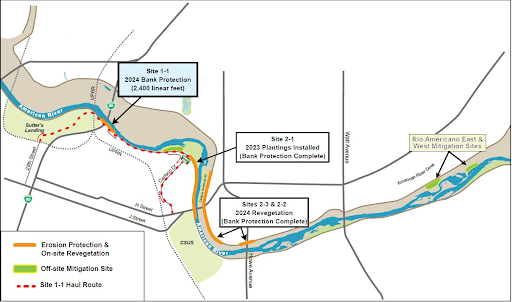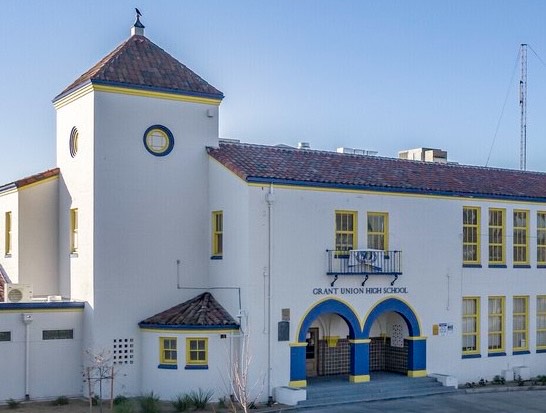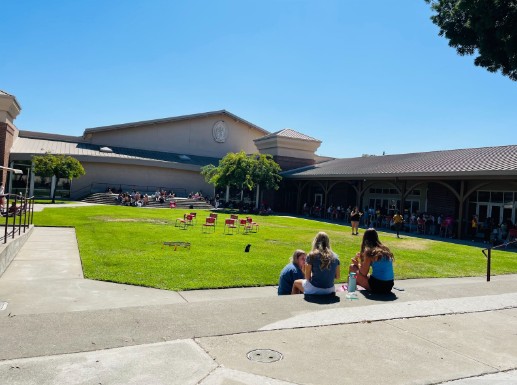Sacramento environmental groups are raising concerns about flood management construction on the American River slated to reach the Rio Americano High School area next year.
The controversial ongoing work, part of the Sacramento Levee Upgrades project run by the U.S. Army Corps of Engineers, has come under scrutiny since beginning last year, as the erosion prevention measures have required the removal of trees and plants along the river.
Up to 600 trees, including 100-year-old heritage oaks, will be bulldozed, according to the American River Trees group.
However, the Army Corps has said the work is necessary to prevent potential catastrophic flooding. The work is designed to update the Army Corps’ standards from planning for a 50-year flood event to a 200-year event.
The American River Parkway is “one of the most at-risk areas for flooding in the United States,” the Army Corps says on its website. (The Army Corps declined several requests for an interview and instead referred SacSchoolBeat to the general construction webpage.)
In a web statement the USACE said: “Several levee sections along the American River were identified as being susceptible to significant erosion from the higher, longer releases from Folsom Dam. The proposed bank protection work will armor the riverbank to reduce and prevent erosion which, if left unaddressed, could result in levee failure.”
Project planners have admitted that the work will bring some disruption to local plants and wildlife.
Coming to the Rio Americano Area
The work near the school, part of the “Rio Americano West and East Mitigation Sites,” was slated to start in July but has been delayed until early 2026. Some vegetation clearing may begin late this year.
The two sites are just behind Rio Americano High near Morris Way and Jacob Lane.
The project, part of Contract 3B, will see several acres of revegetation and habitat replacement to account for wildlife disruptions from flood management work farther west, which has been taking place along the levee for the last few years.
Erosion protection and flood management infrastructure has already been installed behind Campus Commons, the H Street bridge and near Howe Avenue. Contract 3B will expand that work between Howe and Watt Avenue. in addition to the Rio Americano mitigation sites.
At the Rio Americano sites, the valley elderberry longhorn beetle and western yellow-billed cuckoo will be most affected. Riparian vegetation will be replanted following the work so as to restore the habitat, the Army Corps says on its project website.
The Rio Americano work is primarily meant to offset the negative environmental impacts of construction toward Sac State by creating new riparian habitat.

Project Controversy
The American River Trees group helped convince the Army Corps to extend the Environmental Impact Report for Contract 3B and delay construction.
Pete Spaulding, the lead coordinator for American River Trees, said the organization recognizes the need for erosion control but would like to see a less-invasive approach used.
“It has been delayed a year, but we still have seen no evidence of any design changes or changes to the construction techniques to reduce the amount of trees that are being removed,” Spaulding said.
American River Trees has filed complaints with the Sacramento Board of Supervisors, the Sacramento Area Flood Control Agency and the Central Valley Flood Protection Board. After generating 900 public comments regarding Contract 3B (the work near Rio Americano), the Army Corps agreed to push back the construction timeline.
“When I saw what the Army Corps was doing, it literally breaks your heart,” Spaulding said. “It almost makes you want to cry. If there’s work that needs to be done, do it the right way. This is not the right way.”
The Army Corps will replace 30 types of plants and trees with just six, Spaulding said.
Rio Americano students have been taking a stand against the continuation of the project by working with the Save the American River Association.
Seniors Katherine Hickey and Charlotte Ponder started a school-specific chapter last year and have collected 500 of the 1,000 signatures SARA’s petition to reconsider the construction has received.
“We’re trying to get the Army Corps of Engineers to reform this project for it to be less invasive and less harmful to all of the trees and the ecosystem,” Hickey said.
According to SARA and American River Trees, the levee and river behind Rio Americano follows a relatively straight path, so the area is at little risk for erosion.
“They’re doing this all in the name of erosion control, but it seems counterintuitive that they’re cutting down trees (given) how important trees are for the biological system of erosion control,” Hickey said. “We’re trying to push them to do more research. Their root systems are so vital to protecting the river.”
The Army Corps is “more used to concrete and steel,” she added.
River Access Impacts
Another controversial part of the construction work is that Contract 3B will shut down levee and bike trail access between Howe Avenue and Estates Drive for up to two years.
The area around Rio Americano would be used as an access point for trucks to travel to the construction sites between Howe and Watt, especially the Estates Drive levee entrance.
Traffic near American River Drive would also increase from both construction vehicles and cyclists rerouted from the trail. The parallel trail on the south side of the river will be closed, too.
Many students and teachers use the levee to bike or walk to school, so a full closure would be a major disruption to their commute.
“I take the levee to get to school every day,” said senior Marin Abood, who bikes to school. “It’s safer. It’s more efficient. It’s faster.”
Sierra Oaks and Del Dayo elementary schools are also located near the river.
“Schools and the district do not typically have a formal role in the construction planning process for projects that occur outside of school property,” San Juan Unified spokesperson Raj Rai said.
However, the district will make efforts to notify families of traffic impacts.
The river parkway generates roughly $365 million annually for the economy and attracts eight million visitors, according to the National Wild and Scenic Rivers System.
“The river, as everybody says, is the jewel of Sacramento,” Spaulding said. “It really is unique to a major metropolitan area like this. It’s an incredible source of wildlife and recreation.”









